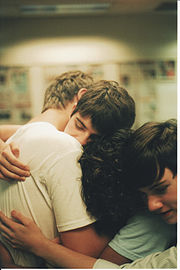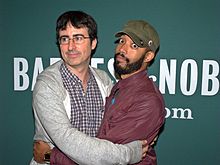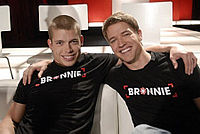- Bromance
-
For the MTV reality series, see Bromance (TV series).
Relationships TypesEnding ofHuman practicesBride price (Dower · Dowry)
Hypergamy · Infidelity
Sexual activity · TransgressionA bromance is a close but non-sexual relationship between two (or more) men, a form of homosocial intimacy.[1]
Contents
Etymology
Bromance is a portmanteau of the words bro or brother and romance. Editor Dave Carnie coined the term in the skateboard magazine Big Brother in the 1990s to refer specifically to the sort of relationships that develop between skaters who spent a great deal of time together.[2]
Characteristics
The contemporary circumstances of bromance separate it from more general homosocial practices and historic romantic friendships.[3][4] Aristotle's classical description of friendship is often taken to be the prototype of the bromance. He wrote around 300 BC, "It is those who desire the good of their friends for the friends' sake that are most truly friends, because each loves the other for what he is, and not for any incidental quality."[1] There are numerous examples of famous intense male friendships throughout most of Western history, and such relationships were likewise common. It has been posited that in the late 19th century, Freudianism and the emergence of visible homosexuality directed heterosexual men to avoid expressions of intense affection.[3]
Research into friendship and masculinity has found that recent generations of men raised by feminist mothers in the 1970s are more emotionally open and more expressive.[1] There is also less concern among men at the notion of being identified as gay and so men are more comfortable exploring deeper friendships with other men.[5][6] Research done in the United States suggests that the trend of rejecting "traditional views of masculinity" is most prevalent amongst men of Anglo-Saxon descent and lowest in those of African descent, with those of Hispanic descent falling in between. Furthermore, it was found that men who strongly endorse "traditional views of masculinity" are more prone to alexithymia (a difficulty to understand or identify with emotions).[7]
Another factor believed to influence bromance is that men are marrying later, if at all. According to the 2010 US Census, the average age of a man's first marriage is 28, up from 23 in 1960. It was also found that men with more education are waiting until their 30s before getting married.[6]
Friendships among men are often primarily based on shared activities. This can include playing video games, playing musical instruments, shopping, smoking pipes, chatting by the fire, watching movies, fishing, camping, and other sporting activities, gambling, social drinking, and engaging in the use of psychedelic substances. Emotional sharing (which is common in women's friendships) is another such activity.[8]
It is not uncommon for people in a homosocial friendship to be physically affectionate with each other, not implying sexual bonding or desire. Hugging, piggybacking, shoulder leaning or teasing are all common features of homosocial relationships, as are frank discussions about sexuality, life, and health. Researchers[who?] believe that the physical aspect of such friendships may actually be an important socializing tool,[citation needed] pointing out that people with less physical contact in their lives can be less socially confident and emotionally stable.
Portrayal of bromance
Celebrity and fictional bromances
A number of celebrities have engaged in bromances with fellow celebrities. Examples include Ben Affleck and Matt Damon, described as "perhaps the pioneering bromance in showbiz history,"[9] which led to a hit off-Broadway play called Matt and Ben.[10] Zachary Quinto and Chris Pine after the filming of the 2009 Star Trek film, have become a modern[11] bromantic relationship, which has its own significance with regards to the characters they play on the film, i.e. Kirk and Spock, a legendary fictional bromantic relationship itself. The close friendship between George Clooney and Brad Pitt, is even described by some as "George's longest lasting affair"[12] and Clooney's bromantic tendencies served as the basis for an episode of the animated series American Dad! entitled "Tears of a Clooney", in which lead character Stan Smith becomes bromantically involved with Clooney as part of an elaborate revenge plot. Brody Jenner, featured on MTV's reality show The Hills and the subject of bromance discussions for his relationships with castmates Justin Bobby and Spencer Pratt, debuted his own series on the network, called Bromance, on December 29, 2008. The six-episode series features Jenner selecting from amongst competitors to become part of Jenner's "entourage".[13]
Bromance on television has also become more commonplace, with some critics tracing its origins back to such shows as The Odd Couple.[14] In October 2008, TV Guide placed Gregory House (Hugh Laurie) and James Wilson (Robert Sean Leonard) on the cover, under the headline "Isn't It Bromantic?". Other shows such as Scrubs and Boy Meets World have also had strong lead characters with serious bromantic relationships.
The legal drama Boston Legal featured one of the more intimate TV bromances, between protagonists Denny Crane (played by William Shatner) and Alan Shore (James Spader). Episodes often ended with both men sitting on the office terrace, sharing cigars, liquor and intimate confidences. In one memorable scene, Denny adjusts his old friend's tie and says "I wish you and I were getting married." Their heterosexual yet clearly very affectionate friendship exhibits strong male bonding aspects derived from their demographic similarity (middle-aged, wealthy professional white men) and shared business experiences. The series ends with Alan and Denny getting married for legal reasons, with the final scene of the two sharing their first dance as man and man on the terrace.
In fiction, what had once been called buddy films have to a degree been re-branded as bromance films, although critics do still draw a distinction between the two, noting that a buddy film tends to be more explicitly violent and less open about its latent homosexual content.[15] The intersection between buddy films and what would come to be called the bromance film was noted comedically at least as early as 1978, when National Lampoon ran a parody ad for the football-themed buddy film Semi-Tough, renamed "Semi-Sweet" and featuring an illustration of stars Burt Reynolds and Kris Kristofferson holding hands.[16] The film I Love You Man stars Paul Rudd as a heterosexual groom trying to find a best man and best friend before his wedding and Jason Segel as his bromantic partner. Also in the film Superbad, Jonah Hill and Michael Cera play the role of best friends Seth and Evan who confess their brotherly love for each other.
In comic books, the most well received among fans is the relation between superheroes Blue Beetle and Booster Gold, established in the series Justice League International, which gained a large cult following.[citation needed] In issue 36 of Booster Gold's comic series Blue Beetle went to state that he and Booster "are practically the same person".
The Daily Show correspondents John Oliver and Wyatt Cenac perform together on the show.[17] When they covered Chelsea Clinton's wedding in Rhinebeck, New York they wore matching outfits and Cenac joked, "We got here this morning -- it's a beautiful place. John and I were thinking we'd get married."[18]
Though the original J. R. R. Tolkien novels predate what could formally be called a "bromance," the portrayal of the relationships between Frodo Baggins and Samwise Gamgee, and Meriadoc Brandybuck and Peregrin Took in The Lord of the Rings film trilogy may be characterized as a bromance.[19]
In the literary Aubrey-Maturin series, Jack Aubrey and his particular friend Stephen Maturin develop a bromance from an initial friendship into a close relationship where each loves the other, often referring to him as "brother." The two heterosexual men cohabitate as bachelors and while they are at sea. They go on to marry a pair of cousins, and generally spend much of their off-duty time together as well.
Sir Arthur Conan Doyle's famous characters Sherlock Holmes and Doctor Watson display bromantic traits throughout the series of stories. Upon being wounded Watson remarks of Holmes's reaction: "It was worth a wound - it was worth many wounds - to see the depth of loyalty and love that lay behind that cold mask. The clear hard eyes were dimmed for a moment, and the firm lips were shaking. For the one and only time I caught a glimpse of the great heart as well as of the great brain. All my years of humble but single minded service culminated in that moment."
Gene and Finny, the main characters of John Knowles' A Separate Peace, were, according to John Heyl, who played the role of Finny in the film adaptation of the novel, "in love – not physically but emotionally." For much of the novel, Gene and Finny share an intense friendship that emerges as a result of the two boys' contrasting personalities. From the offset, Finny shows that he is comfortable revealing to Gene the extent of his feelings toward him, and while Gene's nature causes him to struggle to show his feelings, it is made obvious that he feels the same way.
Relationships that could be described as bromantic extend to the beginnings of literature. In The Epic of Gilgamesh, the relationship between Gilgamesh and Enkidu is described as being very close and explicitly compared to the love between a man and a woman.
Other examples include J.D. played by Zach Braff and Turk played by Donald Faison in the comedy series Scrubs. There is a strong bromance between Prince Arthur and Merlin, the two main protagonists from the BBC fantasy-adventure series Merlin.
Historical and political bromances
Politically, the relationship between Bill Clinton and Al Gore has been characterized as a precursor to the bromance.[6] The relationship between George W. Bush and former press secretary Scott McClellan as told in McClellan's book What Happened was called by one reviewer "the tale of one long, failed bromance".[20] The premiers of Ontario and Quebec, Dalton McGuinty and Jean Charest, have been engaged in what has been described as a "burgeoning bromance".[21][22]
The Biblical story of David and Jonathan is an example of a famous historical bromance. The English classical poet Alfred Tennyson wrote his famous poem "In Memoriam" in memory of his close friend Arthur Hallam. Their extremely close friendship was a famous historical example of a classic bromance.
After the 2010 General Election in the United Kingdom it was considered by some that David Cameron and Nick Clegg formed a type of political bromance as leaders of the coalition government.[citation needed]
Gay protagonists in bromance
Gay-straight bromances
While the term has generally been applied to straight relationships, mixed gay-straight relationships with no form of sexual intimacy have also been dubbed bromances. Examples of well-known gay-straight bromances (sometimes dubbed "homomances" or "hobromances") include Ronnie Kroell and Ben DiChiara from the Bravo reality series Make Me a Supermodel, in which the pair was nicknamed "Bronnie",[23] the relationship on Survivor: Gabon between Charlie Herschel and Marcus Lehman,[24] and American Idol's Kris Allen and Adam Lambert, which was given the name "Kradam".[25] On the show "Big Brother 12" the straight married Matt Hoffman and openly gay Ragan Fox refer to themselves as a bromance. John Barrowman, who is openly gay, and fellow Doctor Who cast member David Tennant are another example of a gay-straight bromance.
Gay-gay bromances
Examples of strictly platonic love between two or more homosexual and/or bisexual men have existed since the dawn of the gay male community.[citation needed] Close, non-sexual relationships between gay men are seen as an important part of any gay man's emerging formation of self and identity following their exit from the closet. Prior to coming out as gay, men often do not have anyone to share their true feeling with, so these gay bromances serve an important part of self-discovery, support and bonding. Examples of gay bromantic relationships can be seen in films such as Love! Valour! Compassion! and And the Band Played On. The notion of a gay bromance is the central focus of the television show Queer as Folk, both the UK and U.S. version. The show Noah's Arc is one in which gay male friendships within the African American and Latino communities are examined. Traditionally, by the very nature of their being gay, some gay bromantic members refer to each other as their "sisters". An occurrence which, for some, posits these relationships as closer than that of traditional straight male friendships, which are typically not as emotionally intimate, but offends other gay men as somehow feminizing the participant members of these friendships. Occasionally, gay male bromances can become complicated if one or more of these friends becomes sexually attracted to the other.
E. M. Forster's novel Maurice deals with a platonic relationship between two gay men prior to (and indeed following) each man's implicit disclosure of his homosexuality to the other.
See also
- Buddy film
- Homosociality
- I Love You, Man
- Male bonding
- Man date
- Showmance
- Romantic friendship
- Womance
References
- ^ a b c Elder, John (2008-10-18). "A fine bromance". The Age. http://www.theage.com.au/national/a-fine-bromance-20081011-4yst.html?page=1. Retrieved 2008-10-28.
- ^ Elliott, Tim (2007-08-23). "A grand bromance". The Age. http://www.theage.com.au/news/relationships/a-grand-bromance/2007/08/23/1187462423868.html. Retrieved 2008-10-28.
- ^ a b Deresiewicz, William (2009-12-02). "Faux Friendship". The Chronicle of Higher Education. http://chronicle.com/article/Faux-Friendship/49308/. Retrieved 2010-01-05.
- ^ Tenden, Per Aubrey Bugge (2007). "Male Imitation: A Look at Gender Performance and the Representation of Masculinity in The OC.". Oslo, Norway: Universitetet i Oslo. http://www.duo.uio.no/sok/work.html?WORKID=58801&lang=en. Retrieved 2010-01-05.
- ^ Phillipot, Suzy (2008-10-06). "I love you, man". The McGill Daily. http://www.mcgilldaily.com/article/4882-i-love-you-man. Retrieved 2008-10-28.
- ^ a b c Bindley, Katherine (2008-03-24). "Here's to 'bromance'". Columbia News Service. http://www.azcentral.com/ent/pop/articles/0324bromance-CR.html. Retrieved 2008-10-28.
- ^ Rowan, George T. et al. (2003). "A Multicultural Investigation of Masculinity Ideology and Alexithymia". Psychology of Men & Masculinity 4 (2): 92–100. doi:10.1037/1524-9220.4.2.91.
- ^ Scola, AJ (2009-04-22). "“Guy Love”: Bromances Prevalent on Amherst Campus". Amherst Student. http://amherststudent.amherst.edu/current/arts/view.php?year=2008-2009&issue=24§ion=arts&article=01. Retrieved 2011-02-11.
- ^ Yaskua, Mitsu (2008-10-29). "11 brands of 'bromances'". dailypress.com. http://www.dailypress.com/entertainment/la-et-bromance-pg,0,384198.photogallery?index=lat-bro_affleck_ekfunfgw20080812102832. Retrieved 2008-10-29.
- ^ Casablanca, Ted (2008-10-29). "Hollywood Bromances: From Leo+Kevin to Matt+Ben". eonline.com. http://www.eonline.com/uberblog/the_awful_truth/b66218_hollywood_bromances_from_leokevin.html. Retrieved 2008-12-14.
- ^ Burr, Nate (2009-04-19). "The Quinto and Pine Bromance Interview". Ponder Pop. http://www.zacharyquinto.com/news/2009/05/video-the-quinto-pine-bromance-interview.html. Retrieved 2010-01-03.
- ^ Synnot, Siobhan (2008-10-18). "I'm a loser in love, admits Hollywood star George Clooney". The Daily Record. http://www.dailyrecord.co.uk/entertainment/2008/10/17/i-m-a-loser-in-love-admits-hollywood-star-george-clooney-86908-20811800/. Retrieved 2008-10-29.
- ^ Yagedaran, Jessica (2008-10-13). "Bromance is in the air". Contra Costa Times. http://www.timesrecordnews.com/news/2008/oct/13/bromance-air/. Retrieved 2008-10-29.
- ^ Gilbert, Matthew (2008-10-29). "From buds to 'bromance'". Boston Globe. http://www.thenewstribune.com/soundlife/story/495543.html. Retrieved 2008-10-29.[dead link]
- ^ Carbone, Gina (2008-08-09). "Pineapple Express review: Stonerhood of the traveling pants". seacoastonline.com. http://www.seacoastonline.com/apps/pbcs.dll/article?AID=/20080809/ENTERTAIN/80809011/-1/rss66. Retrieved 2008-10-29.
- ^ Russo, Vito (1987). The Celluloid Closet: Homosexuality in the Movies (revised edition). New York: HarperCollins. p. 82. ISBN 0-06-096132-5.
- ^ He's not just the token black guy, Jamie Weinman, MacLeans, September 15, 2010.
- ^ Post Wire Service (2010-07-31). "Bill Clinton ignites hubbub in Rhinebeck on eve of Chelsea's wedding". New York Post. http://www.nypost.com/p/news/local/here_comes_the_father_of_bride_tbPCYJmoPuBlAhrHMNJCLJ. Retrieved 2010-10-01.
- ^ "Top 10 Movie Bromances". Time Magazine. 2009-03-20. http://www.time.com/time/specials/packages/article/0,28804,1886693_1886714_1886585,00.html. Retrieved 2010-01-10.
- ^ Kelly, David (2008-06-02). "One Long, Failed Bromance". Paper Cuts (New York Times). http://papercuts.blogs.nytimes.com/2008/06/02/one-long-failed-bromance/. Retrieved 2008-10-29.
- ^ Florida, Richard (2008-10-17). "Ahead of the Curve". The Montreal Gazette. http://www.canada.com/montrealgazette/story.html?id=4066da18-0970-4a9b-94b4-e7dfb70cfd1ee. Retrieved 2008-10-29.
- ^ Campbell, Murray (2008-10-03). "McGuinty and Charest: a fine bromance". The Globe and Mail. http://www.theglobeandmail.com/servlet/story/LAC.20081003.CAMPBELL03/TPStory/TPComment/. Retrieved 2008-10-29.
- ^ Aterovis, Josh (2008-04-06). "Interview with Ronnie Kroell and Ben DiChiara". AfterElton.com. http://www.afterelton.com/people/2008/4supermodelbenandronnie. Retrieved 2008-10-28.
- ^ Juergens, Brian (2008-10-17). ""Survivor: Gabon" bromance update: Marcus likes his fruit". AfterElton.com. http://www.afterelton.com/blog/brianjuergens/survivor-gabon-bromance-charlie-marcus-likes-his-fruit?&comment=56303. Retrieved 2008-10-28.
- ^ TVguidemagazine.com
Categories:- Friendship
- Interpersonal relationships
- Men
- Sociological terms
- 2000s slang
- Words coined in the 1990s
Wikimedia Foundation. 2010.



